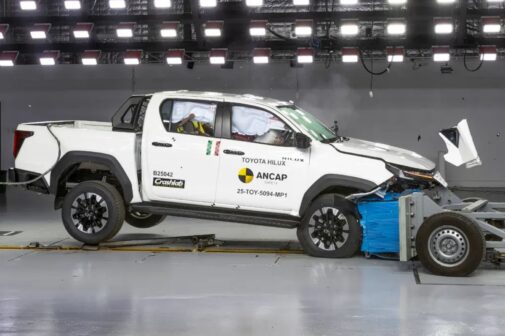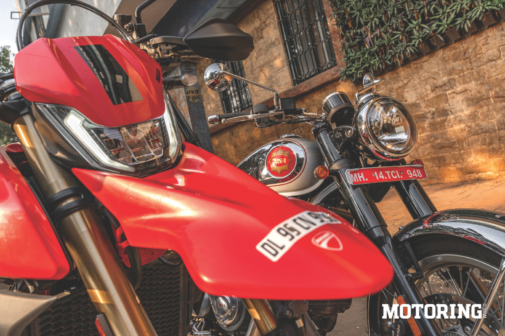The photo on the previous spread may lead you to think that this story is about the title for the ‘Greatest Single Ever’, but it is not; it’s a walkover for the Ducati Hypermotard 698 Mono in that case. This story is about these two big singles — the Mono and the BSA Gold Star, which could possibly shove those big multi-cylinder bikes out of your dream garage. Or at least they did so for me. And it was easy for the Hypermotard to do so. Stupid wheelies and silly slides was its style to charm its way into my heart. The 659cc Superquadro Mono makes the Hyper ‘the smallest Ducati on sale’ and may make you think that it’s just a single, but don’t fall for that; I didn’t, yet every time the engine fi red up, I was elated, surprised and petrified… in that order.
The only time this Hyper feels like a single is while working the gearbox through the city. But on a clear road, past 3000 rpm, it felt like a Golden Retriever that had been waiting all day for its play time. Though I had the leash of fancy electronics to give me a sense of control, it took all my might to keep the Hyper from going…erm, hyper. First gear at 3000 rpm — the front wheel was up. I had the wheelie control on 1, so it was all right. A second later, the front wheel briefly touched the ground, only to back up in the air at around 7000 rpm. I was prepared for the first wheelie, but the second? Who would have thought there’s still some steam left up there? And this routine continued for the first three gears. Given that this engine is one half of the 1299 Panigale, I should have known, but the moment twin underseat exhausts started talking, I just couldn’t let them go quiet.
Even visually, the engine was in-sync with the chaos it represented. From the hoses wrapped around the engine to keep it cool to the serpentine exhaust routing and its heat shield, everything screamed, ‘Performance!’ And right opposite to that was the simple and very retro-looking BSA. The (pseudo) timing wheel cover, the fins and the three-rifle logo, all hark back to the old days… older than this Rotax-sourced engine. The Goldie’s engine looked clean and simple, much like the ride experience it had on offer. The Gold Star’s isn’t a longstroke engine, so, even though it has healthy low-end grunt, it doesn’t have the pull of a longstroke classic. Nonetheless, it never disappointed me. There was always enough torque available for overtakes or even for some random bursts for small stretches. Although, I found 90-100 kph to be the sweet spot, it didn’t mind doing triple digits all day long.
Well, neither did the Hyper, but post 155 kph, the front would become light and weave. But outright speed isn’t what this bike is for, right? It’s the brutal acceleration. Thankfully, the chassis did a brilliant job of keeping the bike right-side up. The Marzocchi forks needed some tuning so that when the Brembo M4.32 calliper bit the 330-mm disc, they don’t use all of the 215-mm travel and get the rear wheel lose contact with the tarmac — which was quite easy to do, by the way. Even with the rear brake, I had to be careful, for the wheel would easily slide, and the electronics would quickly jump in to discipline us. With a retro motorcycle, the expectations aren’t as high, right? Yet, the Gold Star delivered. Well, the suspension wasn’t really pliant, and the rear did transfer jolts to my back, but this was a tradeoff for great handling for spirited riding. And since the brakes had good stopping power, I didn’t feel the need to hold back.
Surprisingly, the Pirelli Phantom SportComp didn’t want me to restrain myself. Blitzing through a sweeping corner at 120 kph? Not a problem! The Hyper flaunted Pirellis, too — Rosso IVs, to be precise — and they stuck to the tarmac like leeches. While the grip wasn’t really a problem with the Mono, the ergonomics were. The dirtbike-like ergos had me seated like… erm, on a dirt bike. But entering a corner with all that grip from the Pirellis (and muscle memory) of course, my mind was struggling between the usual body-and-knee-out posture on a street naked and the leg-out style required on a dirt bike. While the former seemed scary, the latter was confidence-inspiring. Thanks to the area between the tall seat and the footpegs, and the roomy seat, space was never an issue with the Ducati as much as it was with the Gold Star. Though I didn’t have a problem reaching for the handlebar, I felt it would be difficult for shorter riders. My issue was the distance between the seat and the footpegs. A 100-km sprint had me stretching my legs, something I didn’t expect from a roadster. Or maybe, the Hyper had spoiled me.
But at least I could do long hauls with the Gold Star. With the Hyper? No chance. The flat fabric-covered panel that is supposed to be the seat is good for a couple of hours. Though I would have preferred more room for my legs on the Gold Star, I didn’t have a sore derriere even after a three-hour-long ride. The Ducati doesn’t want you to ride for long, though. And I am not even talking about the 16.3 kpl it mustered and the 12-litre fuel tank. The Hyper’s constant urge to ride on one wheel, get to the speed limit in ridiculously short times and the complementary windblast asked me to take small breaks every now and then to regroup. But even when off the bike, it was hard to wipe off that grin and a buzzing sense of heightened alertness that only a morning cup of some strong coffee can induce.
With the Gold Star, I got off with a smile every time. Just like the Hyper, I covered almost 250 km in a full tank, but the experience was quite the opposite. The Gold Star offered me a chance to slow down, enjoy the vistas if I wanted to, and get back to triple-digit speeds whenever it pleased me, unlike the Hyper. But what a pair would these two be for a two-bike garage, right? One for those all reckless and even life-threatening decisions, and one for feeling thankful for life and the smaller things in it after those hasty decisions. Hmm… pretty much sums up the single life, too, no?





















